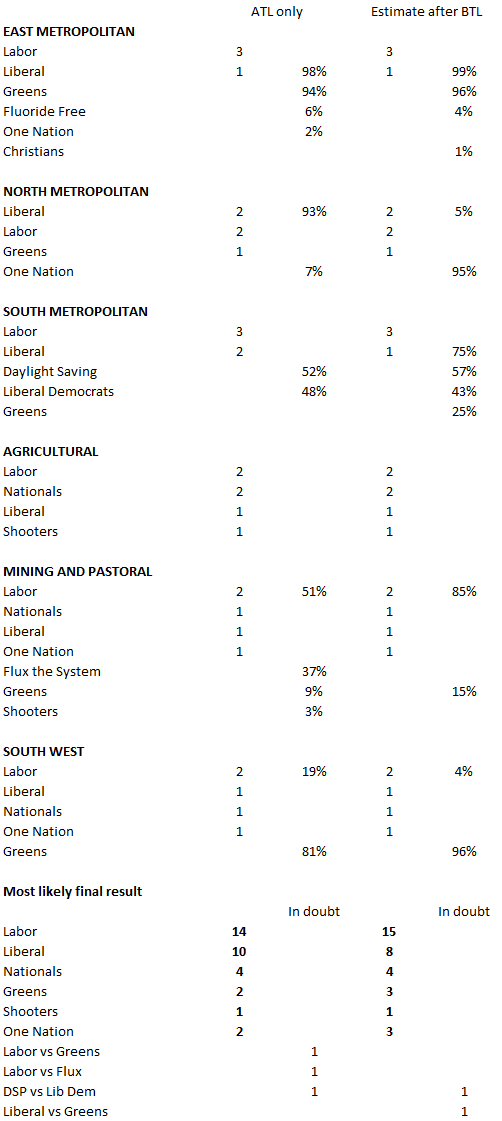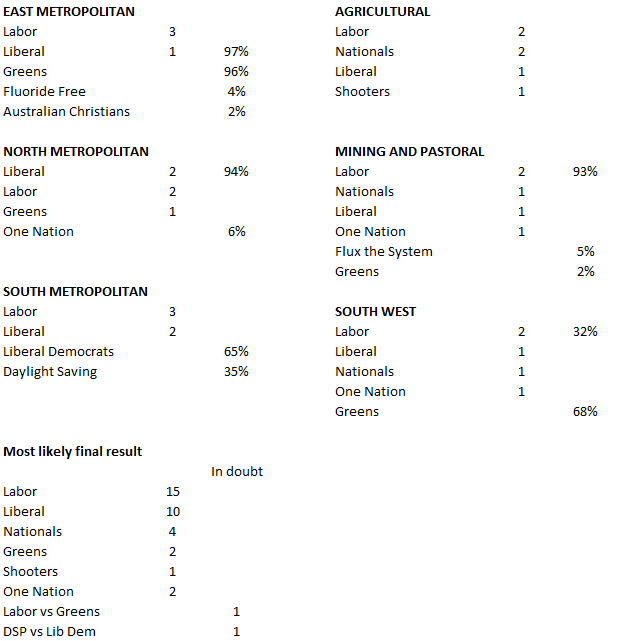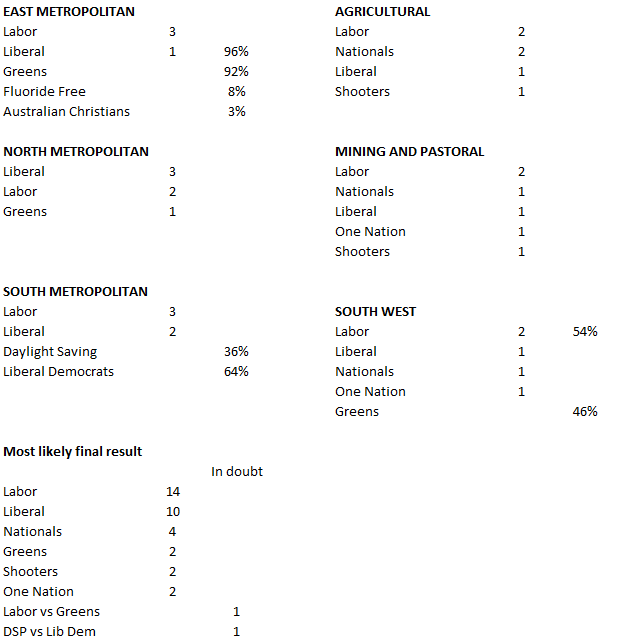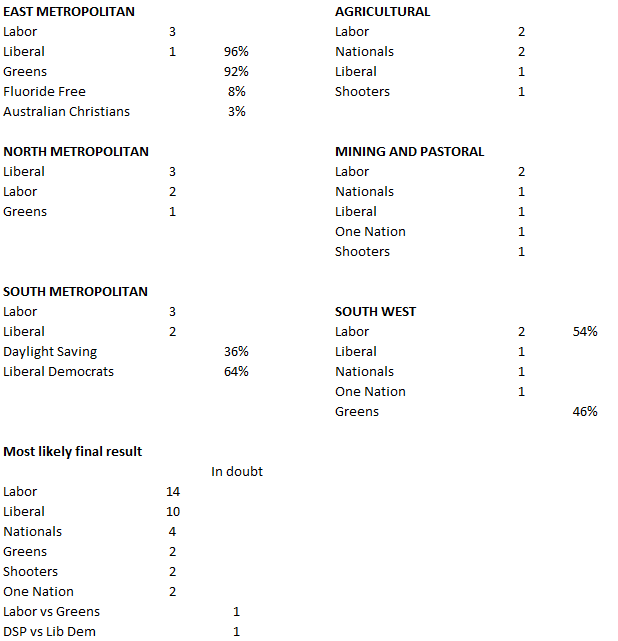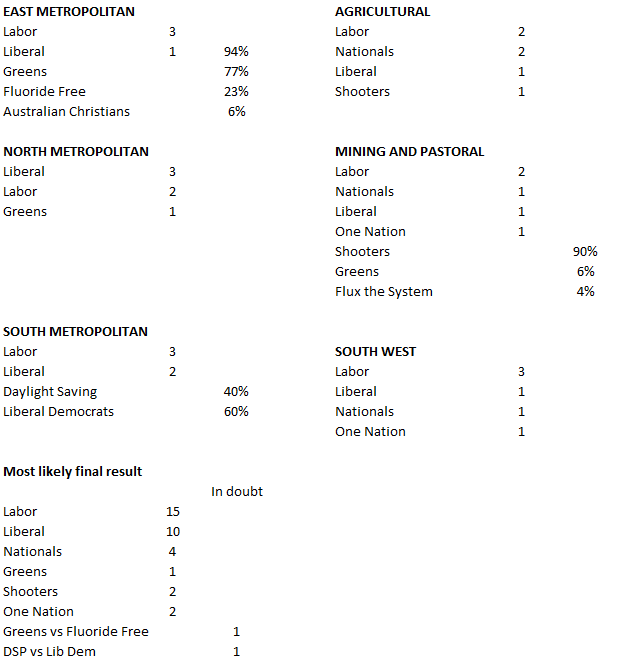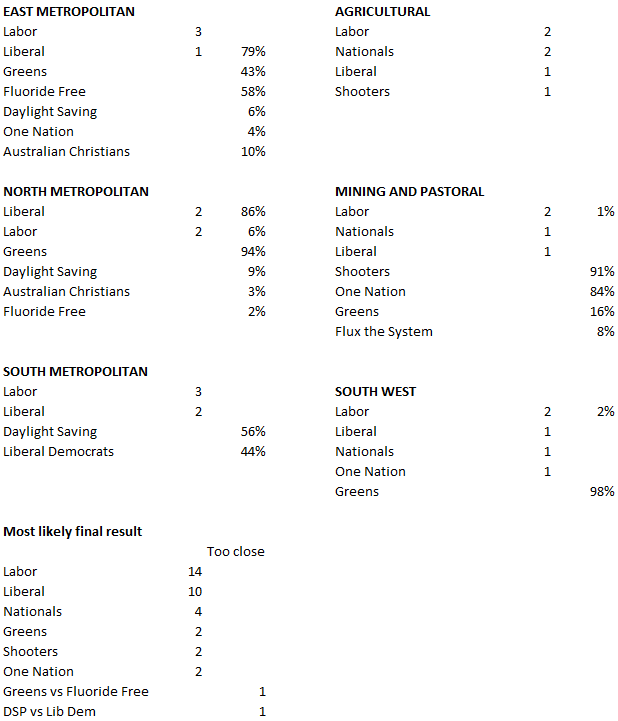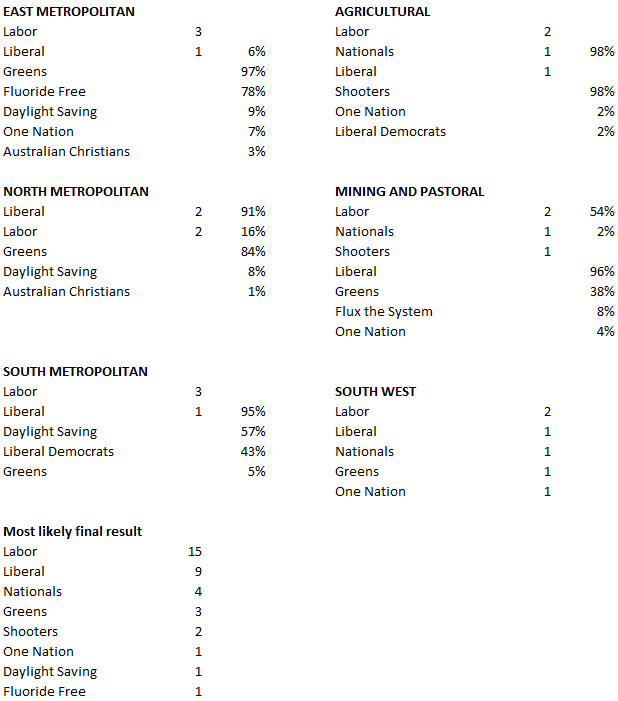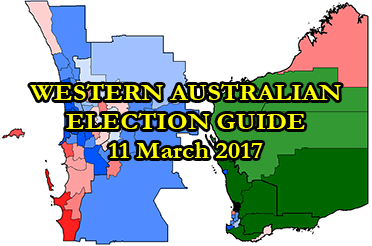Saturday 4.50pm
And now the North Metropolitan preference distribution. The danger spot for the third Liberal, Tjorn Sibma, was the point at which the third Labor candidate, Kelly Shea, was excluded. At this point, Sibma had 33,298 votes to Shea’s 31,561. Had this been reversed, Sibma would have dropped out and his preferences would have elected One Nation to the fifth seat; after which Shea would have dropped out, and Xamon would have been elected to the sixth seat. As it transpired, Xamon was elected to the fifth seat after Shea’s exclusion with a large surplus, which then flowed to Sibma ahead of One Nation.
Saturday 4.10pm
Here’s a pic of the South Metro distribution (HT: Grahame Bowland). With a quota of 49,570, the Liberal #2, Simon O’Brien, emerged with 51,332 to 47,591 for Lynn MacLaren of the Greens. The most vulnerable point for the Liberal Democrats was the exclusion of the Daylight Saving Party, who had been given second preference by everyone in the Glenn Druery network. The Liberal Democrats had 14,105 at that point compared with 13,112 for Daylight Saving, and then received the latter’s preferences as the last party standing in the Druery network. That pushed them ahead of Australian Christians and One Nation, and the preferences of the latter put them well over a quota with 59,150. Their surplus of 9580 votes then went mostly to O’Brien ahead of MacLaren, deciding the result.
Saturday 3.55pm
North Metropolitan: Liberal 3, Labor 2, Greens 1. Final result: Labor 14, Liberal 9, Nationals 4, Greens 4, One Nation 3, Shooters 1, Liberal Democrats 1.
Saturday 3.15pm
South Metropolitan: Labor 3, Liberal 2, Liberal Democrats 1. So Lynn MacLaren defeated, and Labor and the Greens only to total 18 in the chamber of 36. Simon O’Brien re-elected for the Liberals, and the government’s efforts to persuade him to become President set to begin in earnest.
Saturday morning
Results below show the four regions that have been called, plus my readings of the situation in the two that haven’t been.

For those of you who have just joined us, yesterday delivered the shock result in East Metropolitan of One Nation’s Charles Smith squeezing out Liberal incumbent Alyssa Hayden for a result of Labor three, Liberal one, Greens one, One Nation one. Two counts remain to be conducted, and are scheduled to take place this afternoon: South Metropolitan and North Metropolitan. South Metropolitan is particularly interesting, as a Labor-Greens majority depends on Lynn MacLaren of the Greens overturning a lead for the second Liberal candidate, Simon O’Brien, based on the above-the-line vote. It also remains to be established who out of the Liberal Democrats and the Daylight Saving Party will become the election’s sole beneficiary of Glenn Druery’s preference network. I was earlier floating the possibility of One Nation edging out a Liberal in North Metropolitan, while not doing so in East Metropolitan. However, the situation in North Metropolitan is different in that One Nation is relying on the Liberals to drop out before Labor, and so far it’s been Labor that has been losing more ground on below-the-lines.
Friday evening
The preference distribution sheet for East Metropolitan can be viewed here, and One Nation’s shock win can now be understood. It was not, as most of us initially assumed, due primarily to unusual behaviour by below-the-line votes, the addition of which took 0.5% from the Liberals’ vote share and 1.0% from Labor, while adding 0.7% to the Greens and making little difference to One Nation. Rather, it was due to an overlooked technical peculiarity of the counting system used in Western Australia, which produced a different result from what would have occurred in the Senate.
When a distribution of a candidate’s preferences occurs in the Senate, either due to their exclusion or their election (applying only to their surplus votes in the latter case), all the relevant votes are usually redistributed before the count moves on to the next step. The exception is when some of the votes being transferred have been reduced in value because they have already been partly used to elect somebody. In this case, distinct counts are conducted for each bundle of votes with a particular transfer value, in order from highest to lowest, each of which can end with a candidate reaching a quota and being elected.
But in Western Australia, each bundle of votes received, regardless of transfer value, constitutes a distinct count. This has become consequential now that we have micro-parties, in this case Fluoride Free, cobbling together large shares of the vote from a bewildering array of sources, in this case sufficient to turn their base vote of 1262 to 29,860 by the time they were excluded. Under the Senate system, all the votes accumulated by Fluoride Free would have been transferred in a single count, since all had a transfer value of one. The result would have been the election of Greens candidate Tim Clifford with a surplus of nearly 6500, mostly in form of the party’s own votes and preferences from Labor, which would then have flowed to the Liberals.
What happened instead was that Fluoride Free’s preferences were dealt out incrementally, up until the point where Clifford crept over the line. If I understand the situation correctly, the Fluoride Free votes were passed on in the order in which they had received them — first their own votes, then preferences from five small-fry independents (most or all of whom were fronts for the Glenn Druery bloc), the Julie Matheson group, Flux the System and the Daylight Saving Party, of which all but Matheson and one of the independents had the Greens ahead of One Nation. The votes accumulated by Clifford to this point where then used up in electing him, and no surplus was transferred.
However, many more of Fluoride Free’s preferences remained to be distributed, and proceeded to do so at their full value between the only remaining candidates: One Nation’s Charles Smith, on 35,759 votes, and the second Liberal, Alyssa Hayden, on 36,718. These were the larger transfers Fluoride Free had received later in the count, and they included the 4552 votes of Animal Justice, which would have mostly been spent electing Tim Clifford under the Senate method, but instead went to Smith ahead of Hayden. Also favouring Smith were the 8292 votes Fluoride Free had received from Australian Christians, 6491 from Shooters and 2269 from the Micro Business Party. Only the Liberal Democrats, with 3355, and Family First, with 3201, had favoured Hayden.
The vote recorded at the final count is 48,178 votes for Smith and 43,327 for Hayden, but the more telling point is that Smith’s score is only 347 votes clear of a quota. Still undistributed at the end of the count was the 1609 vote Greens surplus, which would have gone to Hayden, and 2388 remaining to Fluoride Free, which I’m unclear about.
Friday afternoon
5.45pm. I’m informed that that’s it for the day. South Metropolitan and North Metropolitan are now set to be finalised at 3pm tomorrow.
4.30pm. A shock in East Metropolitan — One Nation wins a seat at the expense of the second Liberal, for a result of Labor three and one apiece for Liberal, Greens and One Nation.
3.30pm. The WAEC is now going through South West, East Metropolitan and, most interestingly, South Metropolitan, with North Metropolitan to be conducted tomorrow. The South West result is in, and as expected, it’s two for Labor and one apiece for the Nationals, Liberals, Greens and One Nation.
Thursday evening
It seems the WAEC’s indication the four outstanding regions would be resolved today was over-optimistic, and we will now have to wait until tomorrow. The WAEC still hasn’t published the preference distribution files, but you can access them here for Agricultural and here for Mining and Pastoral. To summarise what happened:
Mining and Pastoral: Out of 49,311 formal votes, Robin Chapple’s win for the Greens in Mining and Pastoral came down to margins of 189 votes over Labor at the penultimate count, and 736 over Shooters Fishers and Farmers at the end. The quota was 7045, of which Labor had two off the bat, the Nationals and Liberals one apiece. One Nation got there when the exclusion of Australian Christians unlocked preferences from the Liberals, whose group voting ticket had the Christians second and One Nation third. The final seat came down to Shooters (3507 votes), Greens (2873), Labor #3 (2821), Nationals #2 (2380) and Flux the System (2478), who gathered the micro-party preference snowball. Nationals preferences then flowed to Shooters, and the Flux pinata scattered every which way, leaving the score at Shooters 6563, Greens 3854 and Labor 3665. Labor preferences then flowed to the Greens, who finished with 7389 to the Shooters’ 6653. A different Liberal preference strategy might have elected Shooters ahead of One Nation, or Labor #3 ahead of the Greens (though not both).
Agricultural: There were 88,175 votes in the count and a quota of 12,597. The Nationals started with two quotas, Labor and Liberal with one apiece. The micro-party snowball didn’t amount to much, with the Liberal Democrats going out before the Greens. Labor was then elected with preferences not just from the Greens, but also the Daylight Saving Party, Flux the System and the enigmatic Family First. Presumably this reflected a partial deal with the Glenn Druery bloc, in which the Liberal Democrats and Fluoride Free refused to participate. That left One Nation on 10,777, Shooters on 8,752 and Liberal #2 on 4,241, after which preferences from elected Labor and excluded Liberal went to Shooters, who defeated One Nation at the final count by 13,299 and 10,820. In other words, Liberal preferences could have elected One Nation if they had gone that way, but they actually had them third behind Shooters.
From these results, the effect of adding below-the-lines to the above-the-line totals is to add 0.3% to the Greens vote, and take 0.3% from the Liberals and 0.5% from Labor. If that was borne out in the other four regions, the One Nation possibility in North Metropolitan would disappear, as it is contingent on the Liberals falling behind Labor; and the Greens would fail to get ahead of Liberal #2 in South Metropolitan, in part due to a reduced Labor surplus, but would win their fight against Labor #3 in South West.
Thursday noon
The button has been pressed in Agricultural, delivering the long anticipated result of two Labor, two Nationals, one Liberal and one Shooters. The other four regions were, as of yesterday, scheduled to happen today.
Wednesday 2pm
We have the first finalised upper house result in, so I’m bumping this post. The Greens are relating that Robin Chapple has been re-elected in Mining and Pastoral, in what can only have been a close race against Labor’s third candidate, which presumably means a result of two for Labor and one apiece for the Liberals, Nationals, One Nation and Greens. More on that shortly. The other five regions, last I heard, are set to be determined tomorrow.
Monday morning
Preference counts have been completed and published for 21 of the 59 seats. The key point of interest relates to Kalgoorlie, where until now we could not be sure that the Liberals had won the seats over the Nationals, since there remained the possibility that the Liberal would fall out at the second last count. In the event, Liberal candidate Kyran O’Donnell had 8533 (34.7%) to 6656 (33.6%) for Labor’s Peter Forster, with Nationals candidate Tony Crook bowing out with 4812 (31.7%). With the distribution of Crook’s preferences, O’Donnell prevailed over Forster by 8533 (56.2%) to 6656 (43.8%).
The tables below compare the behaviour of preferences from the 21 seats counted so far with those from all 59 seats at the 2013 election. This is done by adding together preferences as allocated from the relevant party’s point of exclusion, at which point there may or may not be candidates other than the two major parties to pass on preferences to. “Pollution” refers to the combined share of the vote passed on which the relevant party had acquired indirectly as preferences. One Nation preferences did appear to flow quite solidly to the Liberals, certainly in comparison with the federal election, where the split was all but 50-50 (11 of the 21 seats counted had One Nation candidates). Conversely, strong evidence emerges that Greens preferences flowed more heavily to Labor than in 2013. The only seats out of the 21 with Nationals candidates were Geraldton, Kalgoorlie and Murray-Wellington, which may not be representative.

Saturday
Formal distribution of preferences starts today, which presumably means we’re pretty much at the end of the primary vote count, so I haven’t bothered with another update of the results. The picture is clear, with all the close seats (Pilbara, Jandakot, Joondalup, Murray-Wellington and Kingsley) having broken to Labor. Still very much of interest though is the upper house, where we have the rather peculiar situation of what is presumably an all-but-complete count of above-the-line votes, but no information whatsoever on below-the-line votes. The latter are simply being put through the data entry process, without being used to update the first preference count. So we’re pretty much in a state of suspense until the button gets pressed, which is expected on Wednesday or Thursday.
For this reason, I’m now offering two scenarios for my simulations – one based on the raw numbers currently in the system, and the other with rough adjustments made according to how much difference the addition of below-the-lines made to first preference totals in 2013. What this amounts to is an improvement for the Greens (who I’ve bumped 0.3% in Agricultural and Mining and Pastoral, and 0.6% everywhere else), and cuts for the Liberals (down 0.4% in Mining and Pastoral and 0.8% everywhere else) and the Nationals (down 0.4%).
This suggests the Greens are not out of the hunt in South Metropolitan, contrary to what the above-the-line projection has been suggesting, and could deprive the Liberals of a second seat in South Metropolitan — which is to say that it’s not out of the question that there could be a Labor-Greens majority. However, the politics of this are complicated by the fact that the second Liberal is Simon O’Brien, and reports yesterday suggested Labor hopes to tempt him with an offer of the President’s chair. Either way, Labor and the Greens between them would have 18 seats out of 35 on the floor, with the President only exercising a vote in the case of a tie (which would not arise when all members were present).
Another result to emerge from estimating the numbers inclusive of below-the-lines, which I was not expecting to see, is the fairly dramatic possibility of One Nation stealing the Liberals’ third seat in North Metropolitan. The ABC projection shows the danger point is after the exclusion of Family First at Count 19, leaving very little to separate the four remaining candidates: Greens (11.78%), Liberal #3 (10.48%), One Nation (10.45%) and Labor #3 (10.15%). So the Liberals only need to fall back by 0.33% at this point to be excluded, in which case their preferences would elect One Nation. Below-the-line votes should ensure the Greens keep their head above water here, so they look sure to take the other seat that’s outstanding at this point. My cursory examination of past form suggests One Nation at least holds its ground when below-the-lines are added, so this could get interesting.
In another development, the above-the-line projection now shows Labor in danger of losing its third seat in Mining and Pastoral to Flux the System and the micro-party preference snowball, but that won’t happen if below-the-lines behave as they normally do. I’ve also got the Greens improving in the race for the final seat in South West at the expense of Labor #3.
